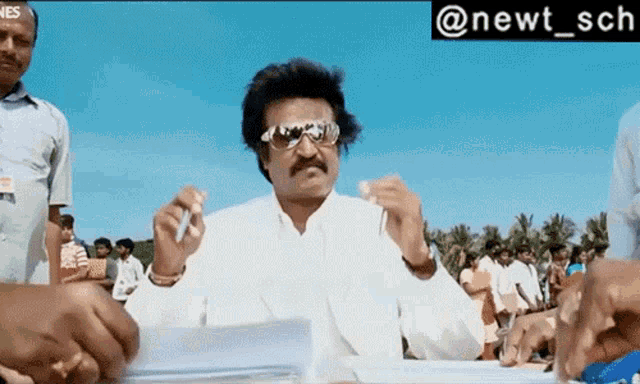Ambidextrous
Unless you are ambidextrous, one hand of yours is stronger than the other. Way stronger. It is capable of multiple tasks at a higher skill level. Putting food into your mouth, brushing your teeth, beating eggs for an omelette - there is a discernible difference between how your dominant arm does it versus the non-dominant arm.
This is not news to you. This imbalance exists in your body, along with many others. And none of them affects you. Until they do. For example, when you overuse/overdo a movement, you get pain. Tennis elbow, when the outer part of your elbow hurts, is an overuse injury. Commonly happens when one plays tennis but can happen to non-players as well from mundane activities.

It is a pain in the ass to write with both hands, not to add that it is unnecessary. But if one hand does 100% of the work in everything and the other does nothing, that's a problem. And that's not the case - you use your non-dominant hand quite a bit.
In fitness, let's expand this from left and right to more attributes you need to pay attention to. To find balance. Not to equalise all of them.
Can run 21k but cannot finish a workout
About 15 years ago, I ran a half-marathon. That's about 21 km - a mind-boggling accomplishment for me, considering I could not run 500 metres a few months prior.
Thanks to the running community, I was able to go from there to something insane - running for 2+ hours.
I was not "unfit" anymore.
Or so I thought.
Then, I went to a CrossFit workout. And I could not last the warmup. I could not finish a full workout until 3 months later. Even though I could run 21 km. I couldn't understand it at all.
3 months later, when I was able to last the full hour in my workouts, I was still pulling my back and doing mundane things around the house. What?!?! Was I not fit?
I needed to understand more.
Fitness is the ability to perform a task.
When I was running, I was fit to run for an hour and cover about 10 km in that hour. Before that, I was not fit to run for 2 minutes.
Being fit to run was not the same as being fit to do a CrossFit workout. Even though there were overlaps, there were a lot of gaps in what that fitness required. Versus what fitness I had.
And even after I was fit to hold my own in a CrossFit class, I was not fit to avoid pulling my back arbitrarily.
You and I want to be able to do a variety of things. Do them to some level of competence. We need general fitness and not just fitness to do a few specific tasks. Why - we are not specialists.
Neeraj Chopra needs to be fit for one task - to throw the javelin far. Anything that does not add to that is irrelevant to his fitness. In his sphere of performance, at the world-class level, that's the focus.
For the rest of us, we want the ability to do a wide variety of tasks reasonably well. I introduced the concept of General Physical Preparedness (GPP) earlier.
Why did I struggle at CrossFit even though I could run 21k? Why did I keep pulling my back even after I was good at CrossFit?
Because of gaps in my GPP.
The blockers
There are 3 primary reasons why you don't think about being well-rounded in your fitness.
- Not having the time for it. If you are someone who has time for fitness, you don't have MORE time for fitness. You are going walking/running/cycling/yoga etc. and cannot add to it. Fair enough.
- Identifying yourself in a box. If you do have the time for it, you do more of what you are already doing. Because you identify yourself as that. I was a CrossFitter - I wouldn't do yoga and I was done with running. You either think it is irrelevant or unnecessary or taboo to do other things.
- Not having the framework for it. When I lifted barbells and was focusing on strength, I could've worked on other aspects of my GPP that would not clash with strength. When I was CrossFitting, I didn't know I could work on my absolute strength.
Let's chip away at each one.
Not having the time for your physical wellness - you need to create time. You are a smart individual. You know you need some form of physical activity in your life. How you make the time for it is a logistical question that you need to solve.
Identifying yourself as a strength athlete or an endurance athlete. Working on other skills will be complementary to your training. It will not pull you down but boost you up.

In the Quad community, we have quite a few folks who are ardent runners. They run multiple times a week. And they travel for a race, at least once a year. One runner who finished a full marathon a couple of weeks ago shaved 80 minutes (EIGHTY) off his previous time. That means they ran every kilometre of the race almost 2 minutes faster. That's a ridiculous betterment. And a small part can be attributed to our coaches who worked on complementary aspects of our student's GPP.
Not having the framework for it. Well, you've already made progress towards that. And we'll chip away a bit more in the next bit of this post.
Strength - Speed - Endurance - Mobility
The four attributes that I'd like you to focus on are:
- Strength
- Speed / Power
- Endurance / Stamina
- Mobility / Joint health / Flexibility
Now, you can dig into each of these and blow them up into many slices. For example, endurance can be broken down based on the energy system - aerobic, glycolytic, and alactic. And each of those can be further broken down - for example, aerobic power, aerobic capacity etc.
We will not be doing that. The focus today is to start building a better framework and mental model about what and why general fitness is the way to go.
And yes, there's agility and balance and more and more things. Yes, they matter. But no, I am not including them here.
I will use myself as an example.
Stage 1: Start
When I started my ultimately successful attempt to improve my physical health and wellness, I couldn't touch my toes. I couldn't run 500 metres. I couldn't lift much weight. I was, however, able to run 100 metres or so rather fast. Let's plot my QUAD.

Don't get too caught up with the numerical values. The story they tell you is accurate - the actual quantity/method to arrive at the metric is irrelevant.
Stage 2: After yoga
I was able to touch my toes. An improvement in my mobility.

So, my mobility component increases a bit.
Stage 3: after 21k
I have completed a 21k in ~2 hours. An insane improvement in my endurance. Let's see how that looks.

You can already see a huge improvement in my GPP from where I started, right?
Stage 4 and 5: CrossFit, followed by strength training.
For brevity's sake, I combining these two. With CrossFit, my strength increased a bit, my endurance increased a bit, my speed/power increased a bit.
After that, I spent a few months working on my absolute strength. As you can see that it is easily my biggest gap.

Stage 6: The Quad Method, and today
By 2011, Raj and I had a working system. We adapted our learnings and created the first version of our method.
And today, after more than a decade of working using that method, here's how things stand.

Strength is the foundation. Everything else springs from it. The ultimate goal is to keep chipping away at the gaps.
A note: At The Quad, we have benchmark workouts and assessments to calculate the score for the 4 attributes. The results of these are put into a formula that takes into account age, gender etc., to arrive at a QUAD.
What next?
Remember, fitness is the ability to perform a task.
And you do NOT need to hyper-specialise here.
If you are looking for general fitness, you are looking to create a QUAD that's as close to a square as possible. This means all the attributes are balanced.
If you are an amateur endurance athlete, you can work on the complementary aspects of speed, mobility, and strength. While endurance will always be your biggest strength (no pun intended), your QUAD area should be high. And this will result in improved running performance.
If you are a fitness aficionado, your first step is to get as close to a square as possible. And then you can work on increasing the size of your QUAD. More area = higher levels of fitness.
As always, remember, enough is enough. At some point, stop with the "more" game. A good-sized QUAD will ensure you look great, feel great, and play your recreational sports at a high level, and your sphere of outside activities will increase. Meaning, you can take up new challenges every year. Hike up to base camp. Work towards a triathlon. Enter a lifting competition. Your foundation is amazing and you can take brief forays into fun things.
